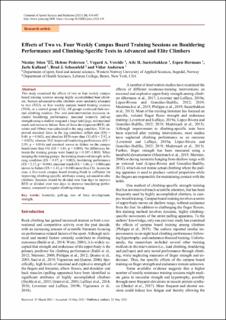| dc.contributor.author | Stien, Nicolay | |
| dc.contributor.author | Pedersen, Helene | |
| dc.contributor.author | Vereide, Vegard Albert | |
| dc.contributor.author | Sæterbakken, Atle Hole | |
| dc.contributor.author | Hermans, Espen | |
| dc.contributor.author | Kalland, Jarle | |
| dc.contributor.author | Schoenfeld, Bratt | |
| dc.contributor.author | Andersen, Vidar | |
| dc.date.accessioned | 2022-02-14T14:10:12Z | |
| dc.date.available | 2022-02-14T14:10:12Z | |
| dc.date.created | 2021-12-17T09:31:15Z | |
| dc.date.issued | 2021 | |
| dc.identifier.citation | Stien, N., Pedersen, H., Vereide, V. A., Saeterbakken, A. H., Hermans, E., Kalland, J., . . . Andersen, V. (2021). Effects of Two vs. Four Weekly Campus Board Training Sessions on Bouldering Performance and Climbing-Specific Tests in Advanced and Elite Climbers. Journal of Sports Science and Medicine, 20, 438-447. | en_US |
| dc.identifier.issn | 1303-2968 | |
| dc.identifier.uri | https://hdl.handle.net/11250/2978874 | |
| dc.description.abstract | This study examined the effects of two or four weekly campus board training sessions among highly accomplished lead climbers. Sixteen advanced-to-elite climbers were randomly allocated to two (TG2), or four weekly campus board training sessions (TG4), or a control group (CG). All groups continued their normal climbing routines. Pre- and post-intervention measures included bouldering performance, maximal isometric pull-up strength using a shallow rung and a large hold (jug), and maximal reach and moves to failure. Rate of force development (RFD; absolute and 100ms) was calculated in the rung condition. TG4 improved maximal force in the jug condition (effect size (ES) = 0.40, p = 0.043), and absolute RFD more than CG (ES = 2.92, p = 0.025), whereas TG2 improved bouldering performance (ES = 2.59, p = 0.016) and maximal moves to failure on the campus board more than CG (ES = 1.65, p = 0.008). No differences between the training groups were found (p = 0.107–1.000). When merging the training groups, the training improved strength in the rung condition (ES = 0.87, p = 0.002), bouldering performance (ES = 2.37, p = 0.006), maximal reach (ES = 1.66, p = 0.006) and moves to failure (ES = 1.43, p = 0.040) more than CG. In conclusion, a five-week campus board training-block is sufficient for improving climbing-specific attributes among advanced-to-elite climbers. Sessions should be divided over four days to improve RFD or divided over two days to improve bouldering performance, compared to regular climbing training. | en_US |
| dc.language.iso | eng | en_US |
| dc.publisher | Department of Sports Medicine, Uludag University | en_US |
| dc.title | Effects of two vs. four weekly campus board training sessions on bouldering performance and climbing-specific tests in advanced and elite climbers | en_US |
| dc.type | Peer reviewed | en_US |
| dc.type | Journal article | en_US |
| dc.description.version | publishedVersion | en_US |
| dc.rights.holder | © Journal of Sports Science and Medicine 2021 | en_US |
| dc.source.pagenumber | 438-447 | en_US |
| dc.source.volume | 20 | en_US |
| dc.source.journal | Journal of Sports Science and Medicine | en_US |
| dc.identifier.doi | 10.52082/jssm.2021.438 | |
| dc.identifier.cristin | 1969738 | |
| cristin.ispublished | true | |
| cristin.fulltext | original | |
| cristin.qualitycode | 1 | |
